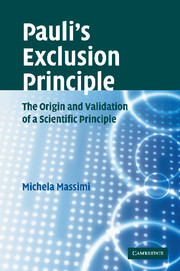Book contents
- Frontmatter
- Contents
- Note on translation
- Preface
- Epigraph
- Introduction
- 1 The exclusion principle: a philosophical overview
- 2 The origins of the exclusion principle: an extremely natural prescriptive rule
- 3 From the old quantum theory to the new quantum theory: reconsidering Kuhn's incommensurability
- 4 How Pauli's rule became the exclusion principle: from Fermi–Dirac statistics to the spin–statistics theorem
- 5 The exclusion principle opens up new avenues: from the eightfold way to quantum chromodynamics
- Conclusion
- References
- Index
3 - From the old quantum theory to the new quantum theory: reconsidering Kuhn's incommensurability
Published online by Cambridge University Press: 07 August 2009
- Frontmatter
- Contents
- Note on translation
- Preface
- Epigraph
- Introduction
- 1 The exclusion principle: a philosophical overview
- 2 The origins of the exclusion principle: an extremely natural prescriptive rule
- 3 From the old quantum theory to the new quantum theory: reconsidering Kuhn's incommensurability
- 4 How Pauli's rule became the exclusion principle: from Fermi–Dirac statistics to the spin–statistics theorem
- 5 The exclusion principle opens up new avenues: from the eightfold way to quantum chromodynamics
- Conclusion
- References
- Index
Summary
The transition from the atomic core model to the electron's spin, the debate on the adequacy of semi-classical models, and the lack of an appropriate scientific terminology are symptomatic of the revolutionary transition from the old quantum theory to the new quantum theory around 1921–5. As such, they provide us with a foil for rethinking Kuhn's view on scientific revolutions. In this view, scientific revolutions are distinctively accompanied by incommensurability between paradigms, or – to use Kuhn's later terminology – untranslatability between scientific lexicons. In the light of the historical reconstruction offered in Chapter 2, I shall here argue for the prospective intelligibility of the revolutionary transition around 1924 via a two-step argument that (1) reconsiders Kuhn's notion of incommensurability as untranslatability (Section 3.2), and (2) offers a positive account of the way the electron's Zweideutigkeit and the exclusion rule came out of the old quantum theory (Section 3.3).
The revolutionary transition from the old quantum theory to the new quantum theory
On 5 November 1980, Thomas Kuhn delivered a lecture at Harvard University entitled ‘The crisis of the old quantum theory: 1922–25’. In his distinctive style of reasoning, Kuhn presented the rise of quantum mechanics after 1925 as the result of a period of crisis of the old quantum theory between 1922 and 1925. The old quantum theory – in Kuhn's view – cannot be regarded as a full-blown theory but rather as a set of algorithms to solve problems and paradoxes.
- Type
- Chapter
- Information
- Pauli's Exclusion PrincipleThe Origin and Validation of a Scientific Principle, pp. 78 - 111Publisher: Cambridge University PressPrint publication year: 2005



